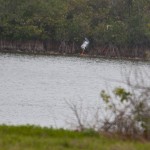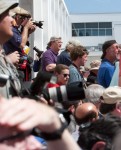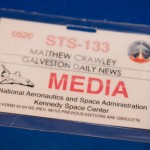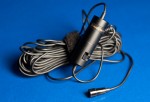
Space Shuttle Discovery takes off from the Kennedy Space Center for the final time on February 24, 2011. Discovery's mission takes it to the International Space Station.
If you are looking for general information about viewing or photographing the launch, I suggest heading over to Ben Cooper’s excellent site, Launchphotography.com.
To see my images from STS-133, head to the gallery.
[T]here is only one shuttle launch left before the program retires and you want to shoot it. Well, I am here to give you a couple of pointers from what I learned covering the launch of the Discovery in February. I don’t claim to be an expert but will point you to a few along the way in this post.
First off, though, I am not going to explain how to get credentialed. I am not trying to keep this exclusive because it isn’t by any stretch of the imagination. I just don’t want to be dropped off in a swamp somewhere by the overworked KSC Media Services staff that with dealt with 1200 credential requests for STS-134. If you are a professional photographer you will know what to do to get credentialed. If you plan on being a fanboy by waving to the astronauts and being generally an idiot, don’t bother. You will inevitably incur the wrath of the photographers around you whose shot you just ruined.
[O]nce you have arrived in Florida, you will need to pick up your credentials before you can enter the Kennedy Space Center and the Press Site. Since the procedures for U.S and foreign media are different, I won’t go into the details – reference your credential approval email. I would suggest you make sure you call and double check the times you can pick up. I wasted half a day driving out there from Orlando because it didn’t dawn on me that it was President’s Day. If you have never been to the KSC, the staff will provide a map and directions.
Equipment
[S]ince you will be 3.5 miles from the pad at launch, you have the opportunity to position remote cameras closer to the pad. These cameras must operate autonomously – NASA is not a fan of stray radio signals. If you think flight attendants are mean when they tell you to shut off all electronic devices to prevent interference with cockpit instruments, you really don’t want to meet NASA’s enforcers. If you are lucky, you will just have to deal with one of the SEAL team’s rumored to have used KSC swamps to train. If you are unlucky, you might have to face the Tweetup participants.
I talked to several photographers prior to photographing Discovery’s launch and everyone suggested going with sound triggers. In particular, Ben Cooper’s advice on remotes for the first time – go simple. Even if you may test and retest your remotes prior to deploying them, expect remotes to fail. Common wisdom is roughly 50% of remote setups fail. This happens for a variety of reasons but most have to do with the environment. At times it is solid water and that is just the Florida air. Joe McNally recounts in The Moment It Clicks that he lost 9 remote setups in an overnight storm shooting a shuttle launch. He was able to salvage one body to mate to an extra 50mm he happened to have.

Camera sound trigger that I used to photograph the launch of the Space Shuttle Discovery in February 2011.
I used built a couple of sound triggers based on a simple sound detection circuit powered by a 9V. The particular circuit I used was based on one published by HiViz.com for educators (HiViz also has ready a made triggers available in their store). The circuit board and 9V battery are housed in a 4x4x2 inch PVC outdoor-grade junction box, which can be found at your favorite home improvement or electrical supply store. I also added some Scotchlite reflective film on the outside of the box, since I knew we might be recovering our camera’s after dark (more on that in tomorrow’s post).
Along with these self-built triggers, I brought a German-designed trigger called the “SmaTrig 2” I had purchased from the creator. Other options for sound triggers are T-minus Productions, and CameraAxe among others. And if you contact me, I may be able to build you one of mine if I have time before the launch.

My remote camera setup sits ready to capture the next day's launch of the Shuttle Discovery on it's launch. The tripod was sitting in the water covered in plastic and staked down and can seen from a distance after being setup on February 23, 2011.
[Y]our cameras will somehow need to be protected to deal harsh environment. There are a number of ways to go from the simple – trash bags – to the complex – multi-camera boxes with automatic doors. Since I was flying, I opted for a variation of the trash bag after consulting with Ben. I used heavy-weight dry cleaning bags to cover my camera’s and equipment.
You may also need to stake your tripod down to handle any wind gusts or storms that come through. Since the soil is relatively sandy, I would suggest using plastic stakes similar to these (which even have shock cords already attached). Most people seem to use bungee cords or zip ties to attach their tripods to stakes.
A couple of notes on microphones: They don’t have to be especially sensitive as the the shuttle’s launch noise will be vibrating your jeans 3.5 miles away. I used a couple of different types. The one that helped me capture the shots above was an Audio Technica lavalier that was taped to top of my lens. You also need to be aware of wind can big a big issue since KSC sits alongside the Atlantic Ocean. At one of my remote sites, the wind was constant and the wind noise kept triggering my camera. I fashioned a makeshift “blimp” out of a plastic bottle to shield the mic. That remote failed for an unknown reason but I suspect that the mic issues may have been the source of failure.
Other things you will need:
- Gaffers tape
- Bug spray – Although they may be natural, I suspect the mosquitoes at Cape are the result of failed NASA experiments to breed a Sputnik-killing insect. They are the size of Chinooks!
- Dry socks – you will get your feet wet setting up and you don’t want to have wet feet the rest of the day
- Sunscreen


